Hydra Z from Audiobyte is a USB audio playback bridge and clock generator whilst the Hydra ZPM is its matching Ultra linear audio power supply. Dan Worth is already a user of the company’s previous model Hydra X+ and most definitely a digital audiophile, so who better to put to put this £1050 combo through their paces.
Once in a while I have the pleasure of reviewing a product which holds strong personal interest for me. The Hydra Z is an SPDIF converter, a bridge which converts the USB output of a computer orientated source to a multitude of digital outputs and at the same time offers clock regeneration with increased jitter control lowering distortion in the noise floor and increasing control over the frequency range.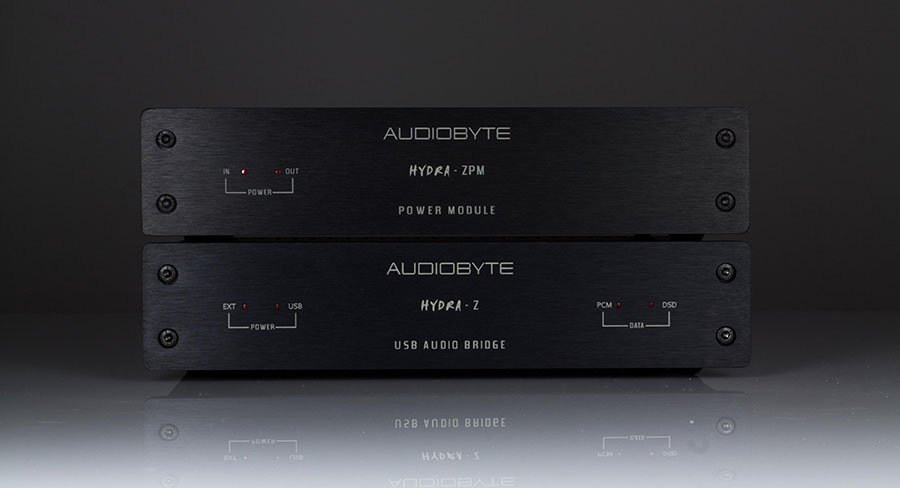
The Hydra Z from Nicolae Jitariu of Audiobyte and Rockna is of particular interest to me as I have been a Hydra X+ owner for a couple years now and I’m familiar with the benefits of the product over any USB direct connection to a DAC. I have heard increasing performance and connectivity flexibility is improved.
The Hydra X+ is a battery powered unit with a switch mode trickle charger enabling playback for up to 10 hours. The Hydra Z however has 3 ways of being powered, firstly from the USB source, secondly from a 5v external supply of linear or switch mode technology and thirdly from Audiobyte’s own ZPM linear based matching form factor power supply, also here for review.
Now I wouldn’t recommend using a switch mode to power the Hydra Z, although there are switch mode supplies from a few companies which I have encountered over the past year or so which offer outstanding audio performance over the cheap wall wart style common supplies. I would always opt for good solid well regulated linear power. The X+’s switch mode supply has always been connected to a separate electrical source than that of my system to eliminate any noise being injected into the rig, even though internally the X+ isolates any of this grunge.
My current X+ has a great range of digital outputs including my favoured HDMI over I2s option (created by Nicolae), coaxial BNC and RCA as well as AES/EBU. All outputs can be used simultaneously which for me has always been a big plus point as I run two of the outputs to two DACs for my main passive and secondary active system. The Hydra Z accomplishes this handy feat also, with the addition of a Toslink Optical output and a Wordclock connection.
If I had one little niggle with the X+ it is that connections to and from the device are on opposite sides of the unit, meaning that the X+ really needs to be placed behind other items on the rack for aesthetic reasons and needs a fair bit of clearance each side for the non-flexible cable ends I have in my system. Hydra Z however is a totally redesigned form factor. The unit has a more traditional styling, a clean front plate with indicators for external or USB power and PCM and DSD designation. The rear of the device now houses all connectivity ports, allowing for the unit to be sat in the rack as most other main units would, allowing for easier isolation support and placement of cabling.
The ZPM linear power supply is identical in form factor and both units side by side on my isolation plinth complete the width of any standard full sized piece of equipment. ZPM has a short umbilical which connects the two units and is designated by a ‘digital’ output, also on the rear is a second power output named ‘analogue’. Audiobyte concentrate their efforts on core products and their website confirmed that currently they offer no other products which could make use of this second output, but talking with Jack Durant of BD audio – distributor here in the UK – he simply said ‘watch this space’. I of course had to press him a little harder and he confirmed that the new form factor products would indeed grow to include additional items which are currently under development.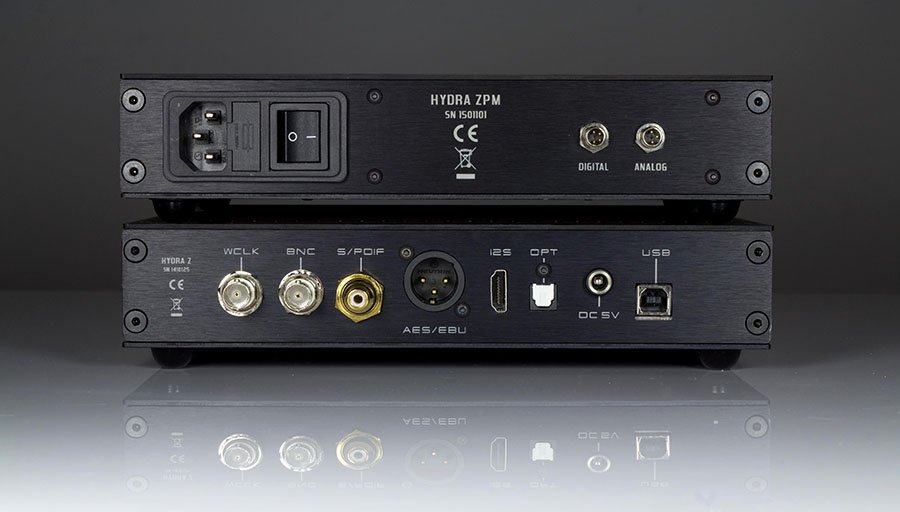
FIT AND FINISH
Hydra Z and ZPM are well constructed and are available in silver or black, the aesthetics of the two units are a little understated and not exactly audio bling, but the casework is solid and of substantial thickness making them both very strong and sturdy – the look almost fits the bill really and represents the type of products Z and ZPM are. Internal PCB layout and implementation of the FPGA circuit is extremely efficient and well laid out. All sockets are of high quality and are positioned to compliment the short signal path.
Packaging again isn’t fancy but it is extremely protective and fit for purpose keeping overall costs to the end user as low as possible.
In comparison with the Hydra X+ the digital processing capabilities of the Hydra Z are much more advanced and powerful, along with being future proof to further advances in bit depth and sample rates, the additional connectivity and wordclock master hub, along with advanced PCB layout and isolation, on paper alone assumed improvements can be made.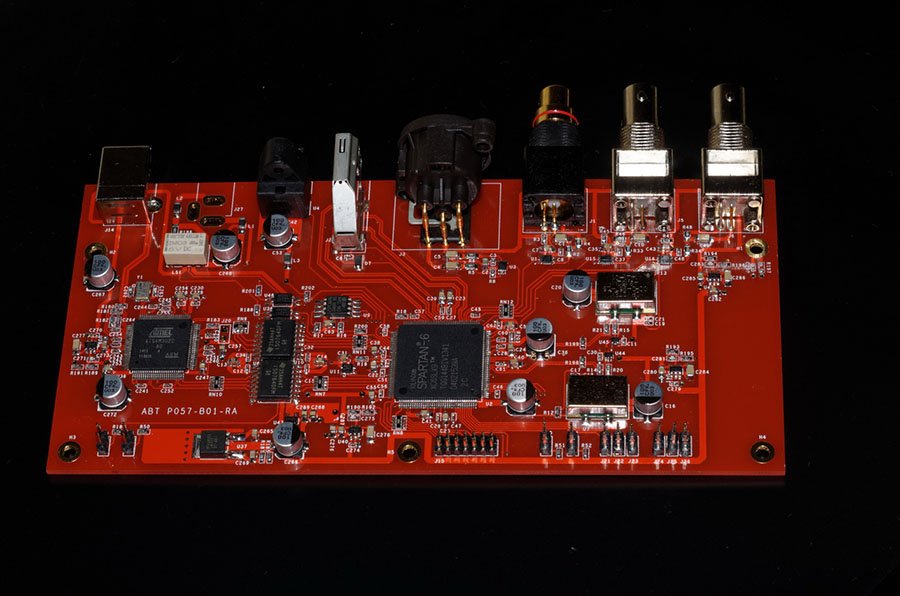
I’ve run a few devices over the years on battery power supplies, including my current X+ but I can confirm that my experience with very well designed regulators within linear power supplies accompanied by tight tolerance transformers made with high grade metals and isolation have won the battle of power source A/B testing. Hydra Z takes a different approach to the battery supply of Hydra X+ (the previous USB bridge from Audiobyte). A separate matching ‘Ultra Linear Power Supply’ from the company has proved from internal testing to be the most effective option, although any 5v supply, switch mode, battery or linear of around 1A of potential output current can be added, along with the ability to power direct from the source computer over USB.
INSTALLATION AND BURNING IN
I have the ability to utilise each and every option from the Hydra Z in my systems, from all the standard digital outputs to the less common but with increasing support I2s over HDMI, as well as the wordclock output.
I’ll note here that I strongly recommend treating the Hydra Z and ZPM when purchased together as one full sized unit, I initially stacked the two items and went through about a weeks burn in, playing music on repeat when I wasn’t listening with the amplifiers off and found that the sound although changed after the initial week was disjointed and lacked flow. Placing the two units side by side had a dramatic effect and music was more palpable and ‘made sense’ again. Complete burn in time I estimate at around two weeks of continuous play – 300 hours or so.
SOUND
Once positioned correctly in the system and played for a few hours after some more running in I wanted to place the Hydra X+ back into my system for a few days in order to bring myself back to the level of performance I had been accustomed too, with the newly run in Hydra Z being able to be swapped in and out I could now evaluate and convey any differences.
The first main difference between the two units is the amount of detail the Hydra Z offers on the outer boundaries of the soundstage. Both units convey a very information rich presentation with the Hydra Z delivering more detail throughout the range. When a piece of equipment can present a lot more information on the outer edges of the room the entire performance grows and the rooms boundaries become less apparent making the recording venue becomes more realistic. This is noticed very well on live performances of an intimate nature, bringing the venue’s acoustics into the listener’s space. Larger more intense collaborations have more drama and three dimensionality that excel the midrange transparency and centre stage depth.
With the advanced performance of Hydra Z, Damien Rice’s ‘O’ album, ‘Older Chests’ has a passage that leads into the perception of a set of patio doors being opened to the left hand side of the soundstage, immediately depth is perceived here as a group of children are heard playing in a park and can be heard laughing and chatting away. The intensity of this section of the music is far more substantial in naturalness with Hydra Z running from the Mac, increasing the complexity and cleanliness of the image, with the previous Hydra it is definite but just not as defined and complex.
Due to the low phase distortion of -114 dBc/Hz @ 10 Hz (which is a true measurement of jitter) what I am hearing and outlined with the previous track is obtained by the decrease in jitter. What always impresses me with Audiobyte is that they offer ‘real’ measurements and figures instead of throwing around the typical ‘lower than XYZ ppm’ numbers and even specify clock and chip model numbers along with supported graphs and links to manufacturers websites for those of a technical mindset to scrutinize. This complete openness is a breath of fresh air amongst the BS that often consumes some products on market.
The lower noise floor of Hydra Z over X+ when just powered via USB within my setup is excellent, making leading edges very accurate and offering less fuzz in the treble. This was undoubtedly aided by the fact my Mac has a strong external linear supply, which I would expect from any hardcore computer audiophile. Hydra Z has excellent isolation and if you wish to add one to a computer source which isn’t intensively modified for audio use its abilities are such that benefits are clearly discernible.
Adding the Z to my standard Mac of matching spec gave significant improvements over a USB direct connection to DAC, giving more insight into recordings, increased vocal separation from the main body of the music, more articulated bass and overall less distortion and grain.
Back to the main setup – leading edges from over X+ are better defined and decays are heard in a more natural and expressive sense. A test track I often mention is Nils Lofgren’s live acoustic version of ‘Keith Don’t Go’. What’s special about this piece of music is the sheer speed and complexity of the guitar work by Nils, being able to hear each decay of the previous note in its own acoustic space whilst following notes overlay without masking the under layers. With the X+ I always felt that the abilities of the unit were very mature and one of the very best converters of its day, but Hydra Z surpasses X+’s abilities to discern additional space, information and clarity around notes and the depth and scale of this performance increases substantially, leaving my beloved X+ sounding a little rounded and softer.
Bass notes with Hydra Z have more prominence and energy, a kick drum sounds more natural with more appreciation of the skin tone and also comes from a slightly more localised position in the soundstage, presented with more focus on its leading edge. Deeper notes had far better extension but very favourably remained tight and didn’t develop into that horrid looseness that can happen where there is more bloom and boom to the bottom end. Instead notes reflected a performance’s scale and flow incredibly well and gave more presence and realism to music.
With the more palpable flow to the sound I was enjoying over the Hydra X+ in my system I intently listened to some good strong vocals to get a handle on any benefits in tonal balance in the ever critical midrange.
A great range of my favourite music consists of beautiful vocals from both females and males alike.
There’s nothing more frustrating for me than to have a system or individual component that cannot produce a convincing vocal. A strong projected vocal that demands attention is an absolute must. One of today’s biggest irritants, especially in mid-priced equipment is a female’s vocal being presented with too much upper midrange which consequently leaves a male vocal thin without lower midrange body or chestiness, this is generally where British mid priced electronics excel and have become a staple for many years.
Hydra X+ always had a great balance here but Hydra Z really pushes the envelope. The projection or dynamic power of the vocal is greater. It’s easier to hear where the vocal begins and how it emanates out towards the listener, growing from the point of origin, rather than just being forward and out of position in the depths of the midrange. There’s also more of that ‘artist in the room’ effect and a more effortless and natural strength to really powerful singers. The upper mids are a step ahead of the previous model, giving more transparency and smoothness integrating the treble in a more liquid nature which picked up on some recordings pitfalls but at the same time never presented the extra detail in an etched manner, yes you can hear more but it’s presented with more sophistication.
Exploring the top end further with a range of material, I can confirm further improvements in air and space, exploring venue acoustics and ambience better. Notes are further fleshed out and the control on treble extremes is better handled with a more relaxed nature and greater feeling of effortlessness.
ADDING ZPM ULTRA LINEAR POWER SUPPLY
After going backwards and forwards a good few times to A/B Hydra X+ and Hydra Z the results speak for themselves, a cleaner, more controlled and defined sound from the Hydra Z came out on top as an undeniable upgrade to the previous model.
Adding the ZPM Ultra Linear Supply only enhanced all of these performance gains further. Where say the leading edge definition had more clarity to the strings of Nils Lofgren’s guitar, they now had a deeper density to them, increasing timbre and the addition of ZPM fleshed out the beginning the middle and the end of each note. Decays were more prominent again I would say. Their volume levels were not increased but their presence was more defined. The lower noise floor of the combination of the two units aided significantly in this area, cleaning up more background hash allowing for the micro details and micro dynamics to now show their prowess, which proves that wherever possible a good clean power is essential throughout the audio chain, even if like me you believe that your mains is already superior. Please don’t question the benefits of the additional support ZPM will give to the music even on a device that one could taken for granted, such as an SPDIF converter.
Piano notes benefited well from the additional clean power. Their tonality was more robust and the softness of strokes were completed with more delicacy in listening tests, along with more impactful hits of keys, conveying additional drama and dynamics. It’s very difficult to reproduce a piano correctly and people spend thousands of pounds/dollars changing and upgrading system components in the analogue domain concentrating purely on piano tone. In the digital domain it is even harder to accomplish strong piano tonality, but as technology pushes forward digital comes closer to the organics of a strong analogue rig and can surpass it when done correctly in my opinion. I feel Hydra Z along with the addition of Hydra ZPM has brought me one step closer to obtaining a more natural tonality with piano as well as all other instruments and vocals, I’d even go as far to say that I would expect my current digital rig to now exceed the performance of a similarly priced analogue set up.
Depth of image also increased with the ZPM power supply in place and image height has better perception along with an additional layer of detail which was surprising to say the least!
The very bottom end rolled and extended cleaner, again with more impact and freedom which firmed up and underpinned the mid and upper frequencies at the same time, reinforcing the lower undertones of the higher frequencies.
The Hydra Z really retained its character and sonic signature when partnered with its matching ZPM Ultra Linear Supply, the additional benefits come in clarity, cleanliness/lower noise floor and layering. When listening to a busy orchestra, individual instruments are more discernible and the same applied to the dance music that I still love. All in all a terrific upgrade, the Hydra Z is the true star here but ZPM just lets the sound breath more.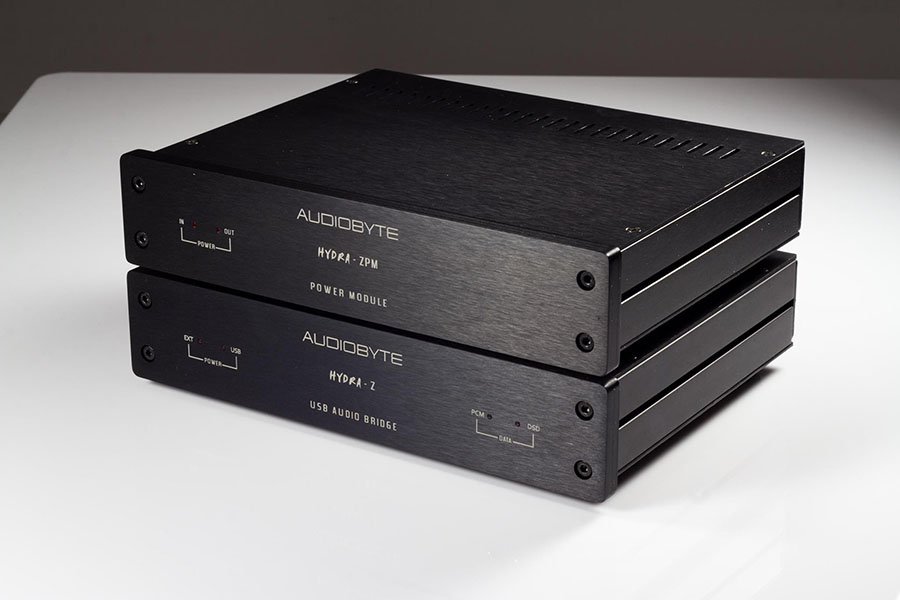
WORDCLOCK
I’ve only had experience with the addition of a wordclock once in my time as a digital audiophile and let’s face it, that is what I am, reviewer comes second. My experience was with DCS products a few years ago and the results were just so flattering to the DAC of that time.
I currently have a Mytek Brooklyn DAC sat on my desk feeding my actives and headphones, it has a wordclock input and output, so why not tether the Hydra Z direct I felt?
The Mytek in short is a unit which crosses the boundaries between pro and home audio and has a sonic signature that gives the listener complete understanding of its roots with a clean insightful and sometimes explicit playback. Adding the wordclock/masterclock from Hydra Z took away a little of the clinical feeling of the Mytek and added more flow to the music, less monitoring and more playback in its characterisation of tones. At the same time I found it to be more phase coherent and conveyed better timing giving a more solid image with better depth and enhanced definition. Bass notes faired particularly well due to this and frequency extremes gained a little more extension and presence without ever becoming too heavy or distracting…in fact the opposite was apparent. The additional control and timing accuracy added denseness and body to the top end, vocals had a stronger feeling of stability, sort of when the signer has spent some quality time warming up their voice. Lower midrange/upper bass gained some transparency and detail also.
CONCLUSION
Computer based audio has a huge position in today’s market with network storage, playback and ripping software, along with music streaming services being the fuel for this designation. Unfortunately what a lot of people overlook is the quality of the signal being fed to the DAC. Even with an expensive DAC, USB chips are still not as far advanced as they will inevitably become and this requires a company such as Audiobyte to design devices such as the Hydra Z in order to isolate the incoming noise from source and lower the jitter on the output signal.
As DAC chips and computer sources progress, for sure too will USB Bridges/SPDIF converters and the crucial part they play with master clock control, enhanced lower jitter rates and digital conversion.
In the digital domain it’s all about ridding the signal of noise pollution and this is done by eliminating phase distortion and ripple from the power source. I demoed many converters before, settling on the Hydra X+ for its detailed and musical sound, although I never liked its form factor, the sound it gave was paramount to my decision.
Hydra Z is a clear statement from Audiobyte that they know how to do digital and have concentrated their efforts on an absolutely crucial part of the audio chain that is so often overlooked by consumers. Enhancing what I believed to be one of the best SPDIF converters I had heard with a product that surpasses it in every area, whilst retaining the musicality, richness of tone and involvement of the previous incarnation. Audiobyte have really got a product here that changes a great digital front end into a truly superb digital front end.
Adding the companies Hydra ZPM Ultra Linear Power Supply again raised the bar, to give an impression of music that makes even more sense and firms up the Hydra Z design with clean and unimpeded power. The Hydra Z is a true statement on its own, accompanied by the ZPM and the combination is just addictive.
I will be trading my beloved Hydra X+ in against the Z and ZPM, the increased performance and design layout is just a no brainer for me.
AT A GLANCE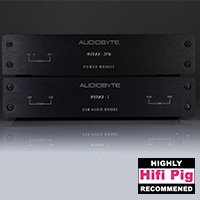
Build Quality : Substantial metal case, good size, abundant amount of connections
Sound Quality: Surpasses Hydra X+ in every way, has superior transparency and detail all presented in a musically engrossing manner
Value for Money: Upgrades this substantial costs thousands if upgrading, for example, a CD player
Pros:
Build quality
Express, detailed, transparent, powerful, coherant sound
Cons:
Nothing other than the warning not to stack the Hydra Z and ZPM as this diminishes sound quality considerably
Price:
Hydra Z – £600 – £640
Hydra ZPM – £450
Dan Worth
SPECIFICATIONS
Inputs
USB receptacle, type B
Outputs
S/PDIF, 75 ohm coaxial
AES/EBU, 110 ohm XLR
BNC 75 ohms
I2S over HDMI (LVDS)
Toslink
Wordclock BN
Supported Sample Rates
PCM
Upto 384 KHz
DSD
2.8 MHz (DSD64) – DoP, native
5.6 MHz (DSD128) – DoP, native
11.2 MHz (DSD256) – native (via ASIO)
22.5 MHz (DSD512) – native (via ASIO)
Bit Depth
32 bit over I2S output
24 bit over S/PDIF, AES/EBU, Toslink
Compatibility
Native MacOS 10.6 and later
Native Linux with UAC2 compliant kernel
ASIO, WASAPI, KS, DS drivers for Win XP to W8 32/64 bit
Recommended players: Foobar2000, Audirvana Plus, Jriver etc.





















































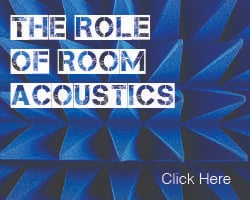



































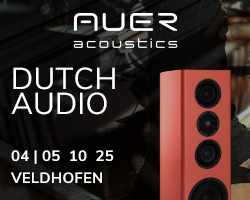












































































































You must be logged in to leave a reply.